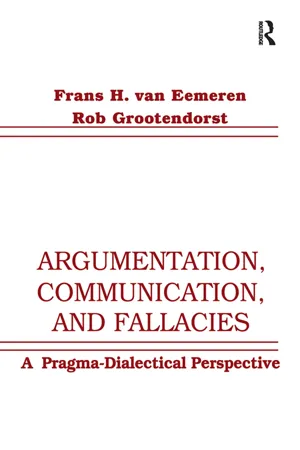Languages & Linguistics
Rhetorical Fallacy
A rhetorical fallacy is an error in reasoning or argumentation that can mislead or deceive an audience. It is a flaw in the logic or structure of an argument that can make it appear more convincing than it actually is. Common examples of rhetorical fallacies include ad hominem attacks, straw man arguments, and appeals to emotion.
Written by Perlego with AI-assistance
Related key terms
5 Key excerpts on "Rhetorical Fallacy"
- eBook - ePub
- Emily Ryall(Author)
- 2010(Publication Date)
- Learning Matters(Publisher)
g) Henry’s handball was yet another example of cheating at the top level. Professional players have too much at stake to play fairly and unfortunately match officials are not always going to be able to spot infringements of this type especially in a crowded goal mouth. Either we introduce goal-line technology or we will see this type of cheating happen all the time and the game will go to ruin.Test Your Understanding
Learning Activity 6.4 State whether the following statements are true or false. a) Fallacies are a form of bad argument. b) Rhetorical ploys are persuasive because they appeal to an emotion or audience’s bias. c) The use of rhetoric is morally unacceptable. d) It is acceptable to use acronyms and technical jargon when your audience is familiar with their meaning.Figure 6.3. Chapter Reviewe) Attacking the person not the argument they make is called ad hominen .f) ‘Tu quoque! ’ is to suggest that the person making the argument lacks credibility.g) To make a deliberately weak counter-argument so you can knock it down easily is to create a straw man. h) The ‘slippery slope’ fallacy is an argument that suggests unforeseen consequences will follow from an action. i) It is never acceptable to appeal to authority in arguments. j) It is important to know where statistics originate from before using them in arguments.What is a fallacy?
A fallacy is a bad argument. It is ‘any trick of logic or language which allows a statement or a claim to be passed off as something it is not’ (Pirie, 2006, pix). An overview of fallacies is given in Figure 6.3 opposite.Further ReadingHamblin, CL (1970) Fallacies . London: Methuen.Although the aim of this book is to demonstrate how the study of fallacies has been neglected from texts on logic, what Hamblin does best is to illuminate the way that fallacies have been considered and developed from a historical perspective. However, what is most striking about this book is that despite its original and engaging content, it is unlikely to appeal to the average undergraduate student, simply because of the aesthetic limitations of a book last published almost 40 years ago. - eBook - ePub
- Siu-Fan Lee(Author)
- 2017(Publication Date)
- Teach Yourself(Publisher)
3 Informal fallaciesIn this chapter you will learn about:• fallacies from the abuse of language• fallacies of relevance– fallacies of appeal– fallacies about premises and conclusion– fallacious induction‘It’s very good jam,’ said the Queen.‘Well, I don’t want any to-day, at any rate.’ (Alice)‘You couldn’t have it if you did want it,’ the Queen said. ‘The rule is, jam to-morrow and jam yesterday – but never jam to-day.’‘It must come sometimes to “jam to-day,”’ Alice objected.‘No, it can’t,’ said the Queen. ‘It’s jam every other day: to-day isn’t any other day, you know.’Lewis Carroll (1871), Through the Looking Glass, Chapter 5We discussed in Section 2.2 some types of unclear linguistic expressions. Not only does the abuse of language lead to misunderstanding, it can also lead to fallacious reasoning. A fallacy is a type of argument that may seem to be correct but on examination is not so. The fallacies due to misuse of language or irrelevance are usually called informal fallacies, to distinguish them from formal, logical fallacies that form invalid arguments (to be introduced later in Chapters 4 –6 ). There are two main types of informal fallacies: fallacies arising from the abuse of language and fallacies of relevance. Just as there are different types of unclear expressions, there are also different types of fallacies arising from the abuse of language.3.1 Fallacies from the abuse of language EQUIVOCATIONExample (1): Time is money. Time heals all wounds. Therefore, money heals all wounds.The fallacy of equivocation occurs when the same word or phrase is used with two or more meanings, deliberately or accidentally, in the formulation of an argument. This is a fallacy due to ambiguity or vagueness.The word ‘time’ is ambiguous in this example and the speaker employs this ambiguity to make the argument. The argument even looks valid: if ‘is’ means identity and we can substitute identical things with each other, then substituting ‘time’ with ‘money’ in the second sentence give us the words as they appear in the conclusion. However, it is in fact not a valid argument. The reason is that the word ‘time’ has different meanings here, so we just can’t simply replace one token of it with what is predicated of another token. - eBook - ePub
Argumentation, Communication, and Fallacies
A Pragma-dialectical Perspective
- Frans H. van Eemeren, Rob Grootendorst(Authors)
- 2016(Publication Date)
- Routledge(Publisher)
argumentum ad populum thrives best in discussions on a broad scale, in which many people consider themselves involved. Not surprisingly, then, it is a fallacy committed not infrequently by politicians and other public figures. Rhetorical ruses of this kind do not resolve differences of opinion but they can, of course, have other functions to the speaker and his audience. They may, for instance, be important in an epideictic sense by emphasizing the group’s unitedness.Parading One's own Qualities
The second way of using nonargumentative means of persuasion to win the audience over is parading one’s own qualities or qualities one attributes to oneself. When the protagonist does so, he deliberately brings his own person into the discussion. He employs ethos, the third category of the rhetorical means of persuasion. According to Aristotle, ethos is generally even more effective than logos and pathos.In conformity with Aristotelian terminology, violations of Rule 4 in which the protagonist’s personal characteristics, expertise or other qualities are emphasized in order to persuade the audience to accept a standpoint, are usually called ethical fallacies. Where an ethical fallacy is committed, the protagonist attempts to get a standpoint accepted by the audience just because of the authority he derives in the eyes of the audience from his expert knowledge, credibility, or integrity. Therefore, this fallacy can be regarded as an argumentum ad verecundiam.55 In the literature on fallacies, little attention is paid to ad verecundiam as an ethical fallacy.An argumentum ad verecundiam can be effective due to the psychological mechanism that the audience is more likely to accept what someone says the more confidence they have in him. In extreme cases, a particularly strong ethos can even render argumentation for a standpoint superfluous. There is no need for it because the audience takes the speaker at his word, going along with whatever he says or proposes.Ethos can also play a part in a less extreme way. According to the Dutch prime minister, Mr Ruud Lubbers, without ethos - eBook - ePub
A Class Room Logic
Deductive and Inductive, with Special Application to the Science and Art of Teaching
- George Hastings McNair(Author)
- 2018(Publication Date)
- Perlego(Publisher)
One in defense, who has a weak case, may be tempted to divert attention from the point in hand, realizing that a close analysis of the matter in dispute will tend to his undoing. In such instances (1) the lawyer will abuse the plaintiff, (2) the demagogue will tell humorous stories, (3) the teacher will take advantage of the ignorance of the pupil, (4) the scholar will refer to authority and (5) the magnate will fall back upon the power of position and wealth. These forms of “rhetorical thinking” are as harmful as they are popular, and furnish one of the chief reasons for giving to the common people a better understanding of “how to think” as well as “how not to think.” Definite names have been given to the various forms of irrelevant conclusion which may be summarized as follows: Argumentum ad populum. This is the fallacy of appealing to the feelings, passions and prejudices of an audience rather than to their good sense and powers of reason. It is probably the most common of the group. To excite sympathy, the lawyer for the defense may speak feelingly of the suffering that an unfavorable verdict will bring to the wife and children of the accused. Argumentum ad hominem. Here the character of the opponent is defamed with a view of discrediting him with the court or audience. “Mud throwing” in times of political agitation is a good example of this fallacy. Argumentum ad ignorantiam. This fallacy comes from taking advantage of the ignorance of the opponent; the fallacy assumes that the original supposition has been proved if one is unable to prove the contradictory of the original. Illustration: Mars is inhabited because no one is able to prove that Mars is not inhabited. Argumentum ad baculum. In this all argumentation is made to give way to the forces of personal opposition and to the power of money - eBook - ePub
- Linden J. Ball, Valerie A. Thompson, Linden J. Ball, Valerie A. Thompson(Authors)
- 2017(Publication Date)
- Routledge(Publisher)
6 Fallacies of argumentation Peter J. Collins and Ulrike HahnIntroduction
The British Parliament recently debated legislation to permit IVF techniques allowing three-parent babies in order to prevent inherited mitochondrial diseases. Opponents objected that the legislation ‘marked the start of a “slippery slope” towards designer babies and eugenics’ (Knapton, 2015) and that it ‘put the UK out in front of a race to the bottom’ in human dignity (Rush, 2015). This slippery slope argument is one of a family of arguments – the informal fallacies – that have traditionally been viewed as persuasive but improper (see, for example, Hamblin, 1970; Toulmin, Rieke, & Janik, 1979; Walton, 2008).Informal fallacies – and accusations of fallaciousness – abound in public reasoning. Take the putatively false analogy in debates about national debt between state and family finances (Krugman, 2012) or celebrity endorsements providing dubious arguments from authority (Walton, Reed, & Macagno, 2008). Are these bad arguments, and if so, why? Are they persuasive? These questions about human rationality parallel those in neighbouring fields, such as judgment and decision-making. Persuasive but bad arguments are to reasoning what biases are to judgment and decision-making, if normative standards for argument quality can be found.Fallacies are widely debated but lack a consensus definition, list, or taxonomy, hence are best understood by example. Table 6.1 lists representative fallacies, with examples and explanations.How one defines fallacies depends on which norms one accepts for arguments. Historically, fallacies struck researchers as arguments that, to some, seem valid – thus persuasive – though they are in fact logically invalid (Hamblin, 1970). This definition presupposes formal logic as a standard for arguments (van Eemeren & Grootendorst, 1995). Certain fallacies follow from this view: in our table, ‘formal’ fallacies follow from classical propositional and predicate logic, syllogistics, and standard modal extensions.
Index pages curate the most relevant extracts from our library of academic textbooks. They’ve been created using an in-house natural language model (NLM), each adding context and meaning to key research topics.




